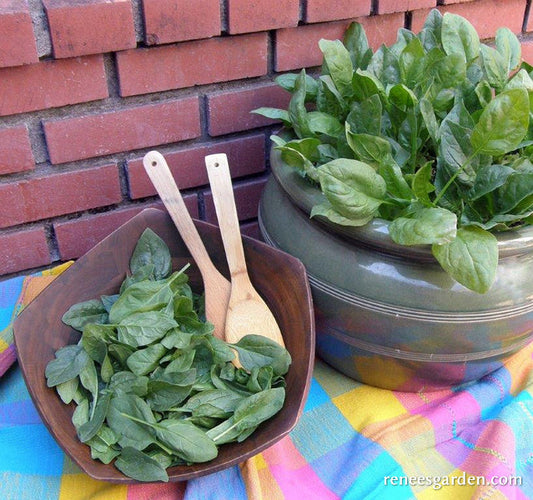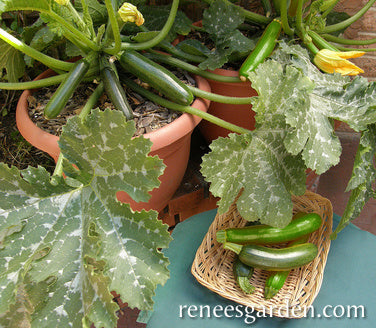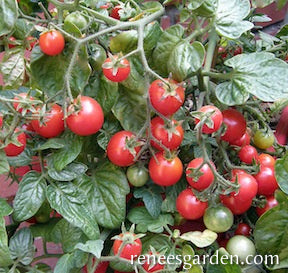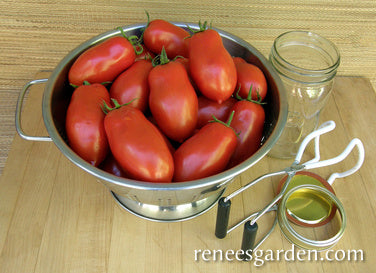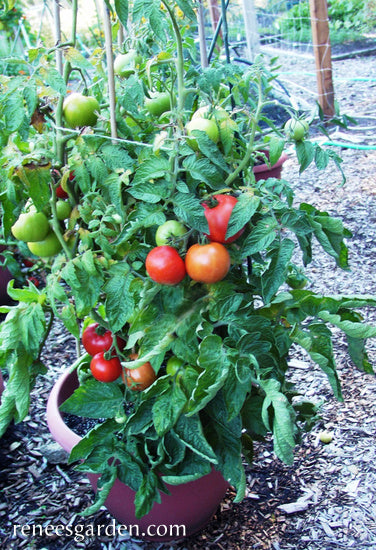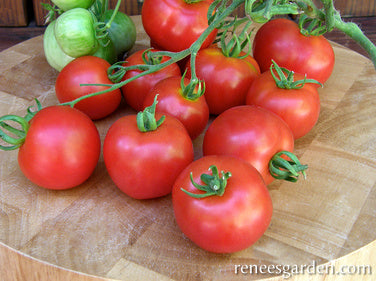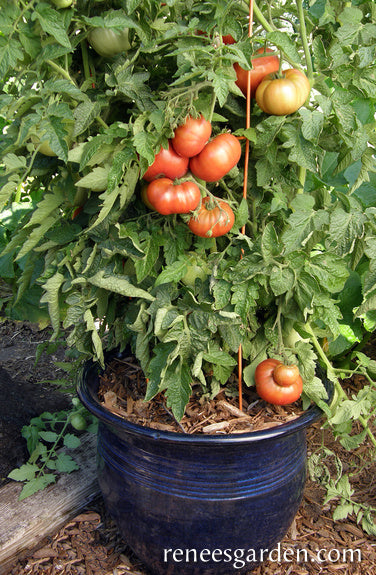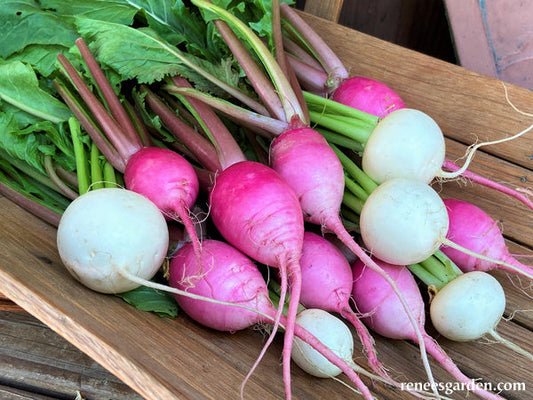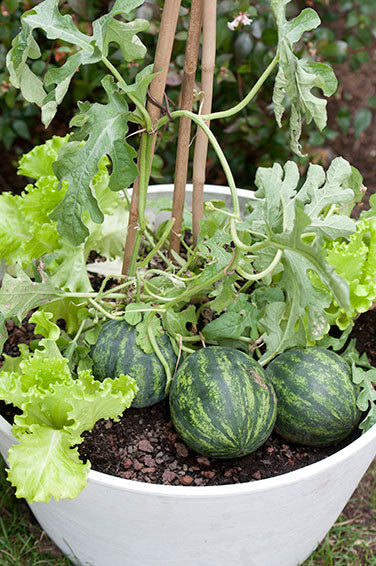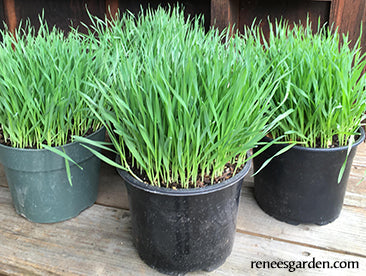Container Vegetable Collection
Container Vegetables
Space-saving varieties are our specialty! Packets include complete instructions for growing these vegetables in containers. You can enjoy a beautiful and bountiful garden even if you don’t have lots of room.
-
Container Baby Leaf Spinach Little Hero
CONTAINER PLANTING
Plant in early spring when danger of hard frost is over. Use a pot at least 15-18 in. in diameter and 12 in. deep, and start with fresh potting mix. Sow seeds 2 in. apart or simply broadcast seeds thinly, aiming for 2 in. spacing. Cover with 1/2 inch of potting mix and firm soil well over seeds. If first sowing germinates unevenly, plant more seed as seedlings will catch up fast.
GROWING NOTES
Birds love tender young seedlings, so protect as necessary with netting or floating row cover. Sow again in late summer for a fall crop. Keep spinach well watered and weeded and fertilize every few weeks and especially after harvesting.
HARVEST AND USE
To harvest by the “cut and come again” method: when plants are 4 to 5 in. tall, cut as much as you need, by using scissors to shear off leaves 1 to 2 in. above the soil level. Water well and fertilize lightly and plants will regrow for several more cuttings. Little Hero’s tender, baby leaves are delicious in fresh salads with additions like thinly sliced sweet onions, sliced radishes, thin wedges of apple or orange, toasted nuts, chopped scallions, crispy bacon bits, hard-cooked egg quarters and grated cheese. Or stirfry, braise or sauté very quickly for healthy, tasty greens.
Regular price $3.99Sale price $3.99Unit price / per -
Baby Salad Spinach Regiment
TO START OUTDOORS
In early spring when danger of hard frost is over, sow seeds in well-worked fertile soil in full sun. Space seeds 1 inch apart in rows 8 to 10 inches apart, or broadcast thinly for bed planting. Be sure to firm soil well over seeds to ensure good germination. If first sowing germinates unevenly, plant more seeds as they will catch up fast.
GROWING NOTES
Spinach is most productive grown in cool spring conditions and sown again in late summer for a fall crop. After seedlings reach 2 to 3 inches tall, thin out every other plant (and enjoy in early salads) and keep thinning in this fashion until plants are spaced 5 or 6 inches apart. Keep the shallow rooted plants well weeded and watered. Spinach is a heavy feeder so fertilize several times with fish emulsion solution for best harvests.
HARVEST AND USE
There are two methods for harvesting spinach: either cut the entire plant 1 inch or so above the base once plants are 4 or 5 inches tall, or wait until plants are well established and harvest just the outer leaves, leaving at least 4 center leaves so plant will continue to grow. Water and fertilize after cutting and plants will provide 2 or 3 pickings before weather gets too warm and spinach begins to go to seed.Regular price $4.89Sale price $4.89Unit price / per -
Container Zucchini Astia
START SEEDS OUTDOORS
Plant only when weather has warmed up and nights are above 50°F (10°C) Amend soil well with aged manure or compost. In a sunny spot, make slightly mounded hills, 3’ wide and 3’ apart. Sow seeds in a triangle on each mound, planting two seeds 1” deep at each point in the triangle. Thin to the strongest seedling at each point, leaving 3 seedlings per mound.
FOR CONTAINERS
Use fresh, good quality potting soil in containers. For a pot 15 in. across and 12 in. deep, sow 2-3 seeds in center. When seedlings reach 3-4 inches, remove all but 1 strong seedling. For pots 18-20 in. across and 12-15 in. deep, sow seeds 4 inches from container edges, then thin to 2 plants per pot. For larger pots, thin plants to be 8 in. apart. Mulch to help conserve moisture and fertilize monthly for good production. In hot weather, check and water containers daily.
GROWING NOTES
Protect seedlings from marauding birds with plastic berry baskets, removing before plants get crowded. Thin plants properly; you’ll get more zucchinis from a few well-spaced, healthy vines than from crowded plants that are much more disease prone.
HARVEST AND USE
Harvest at about 5 inches in length; frequent harvesting keeps plants producing. Enjoy these zucchinis grilled, baked sautéed or steamed. Try slicing lengthwise, drizzling with olive oil and roasting to succulent perfection. Or slice 1/2 inch thick, top with pizza sauce and cheese and bake.Regular price $4.99Sale price $4.99Unit price / per -
Windowbox Tomatoes Litt'l Bites Cherry
STARTING SEEDLINGS
In early spring, start indoors about 6 weeks before night temperatures are reliably in the 50-55°F (10-13°C). Sow seeds 1/4 in. deep and 1 in. apart in a container of seed starting mix. Keep moist but not soggy, and very warm, 80°F (27°C). Provide a strong light source until seedlings are ready to plant outside. When seedlings are 2 in. tall, transplant into individual 4-in. pots. Maintain at 70°F (21°C). Feed with half-strength fertilizer every 2 weeks until ready to plant. When night temperatures are reliably in the 55°F (13°C) range, gradually acclimate to outdoor conditions.
Container Growing: Transplant one seedling per pot or basket that is at least 16 in. in diameter and 16 in. high. Container tomatoes need a location with at least 6 hours of sun per day. Use fresh potting mix to prevent soil borne disease. Mulch plants well and water regularly: in hot weather, pots may need water daily. Fertilize every other week with a low nitrogen fertilizer for strong plants and good yields.
HARVEST AND USE
Litt’l Bites plants cascade attractively from their containers and are soon covered with tasty little cherry tomatoes. Pick and enjoy these cute little baby tomatoes frequently when red ripe to encourage the most production. For best flavor don’t store Litt’l Bites in the fridge.Regular price $4.99Sale price $4.99Unit price / per -
Container Roma Tomato Inca Jewels
STARTING SEEDLINGS
In early spring, start indoors about 6 to 8 weeks before outdoor night temperatures are reliably 50-55°F (10-13°C). Sow seeds 1/4 inch deep and 1 inch apart in a container of seed starting mix. Keep moist but not soggy, and very warm, 80°F (27°C). Provide a strong light source until seedlings are ready to plant outside. When seedlings are 2 inches tall, transplant into individual 4-inch pots. Maintain at 70°F (21°C). Feed with half-strength fertilizer every 2 weeks until ready to plant. When nights reach 55°F (13°C), gradually acclimate to outdoor conditions. Plant these vigorous, early bearing vines 3 feet apart into rich soil in full sun.
GROWING IN CONTAINERS
Transplant one seedling per container; minimum pot size should be 18 to 20 inches in diameter and 18 inches high. Use fresh potting mix to prevent soil-borne disease. Water regularly: containers may need water daily in hot weather. Fertilize every other week with a low nitrogen fertilizer for strong plants and good yields. Growing Notes Plant seedlings several inches deeper than they were in seed starter. Provide strong 3 ft. stakes or tall wire cages at planting time as plants get heavy with fruits and need support. Mulch to provide even moisture retention; don't overwater once fruit begins to ripen.Regular price $4.99Sale price $4.99Unit price / per -
Container Tomato Super Bush
STARTING SEEDLINGS
In early spring, start indoors about 6 to 8 weeks before outdoor night temperatures are reliably in the 50-55°F (10-13°C). Sow seeds 1/4 inch deep and 1 inch apart in a container of seed starting mix. Keep moist but not soggy, and very warm, 80°F (27°C). Provide a strong light source until seedlings are ready to plant outside. When seedlings are 2 inches tall, transplant into individual 4 inch pots. Maintain at 70°F (21°C). Feed with half-strength fertilizer every 2 weeks until ready to plant. When nights reach 55°F (13°C), gradually acclimate to outdoor conditions. Plant these vigorous, early bearing vines 3 feet apart into rich soil in full sun.
Grown In Containers: Transplant one seedling per pot with a minimum size of 18 to 20 inch diameter and 18 inches high. Use fresh potting mix to prevent soil borne disease. Water regularly: in hot weather, pots may need water daily. Fertilize every other week with a low nitrogen fertilizer for strong plants and good yields.
GROWING NOTES
Tomatoes need full sun at least 6 hours every day. Provide strong stakes or wire cages at planting time as plants get heavy with fruit. Mulch plants well to maintain even moisture. Pick fully ripe. Don’t store tomatoes in the fridge.
Regular price $4.99Sale price $4.99Unit price / per -
Early/Container Tomato Heirloom Stupice
STARTING SEEDLINGS
In early spring, start indoors about 6 to 8 weeks before outdoor night temperatures are reliably 50-55°F (10-13°C). Sow seeds 1/4 inch deep and 1 inch apart in a container of seed starting mix. Keep moist but not soggy, and very warm, 80°F (27°C). Provide a strong light source until seedlings are ready to plant outside. When seedlings are 2 inches tall, transplant into individual 4 inch pots. Maintain at 70°F (21°C). Feed with half-strength fertilizer every 2 weeks until ready to plant. When nights reach 55°F (13°C), gradually acclimate to outdoor conditions. Plant these vigorous, early bearing vines 3 feet apart into rich soil in full sun.
Grown In Containers: Transplant one seedling per pot; with a minimum size of 18 to 20 inch diameter and 18 inches high. Use fresh potting mix to prevent soil borne disease. Water regularly: in hot weather, pots may need water daily. Fertilize every other week with a low nitrogen fertilizer for strong plants and good yields.
GROWING NOTES
Tomatoes need full sun at least 6 hours every day. Provide strong stakes or wire cages at planting time as plants get heavy with fruit. Mulch plants well to maintain even moisture. Pick fully ripe. Don’t store tomatoes in the fridge.Regular price $4.89Sale price $4.89Unit price / per -
Heirloom Container Tomatoes Tasmanian Chocolate
STARTING SEEDLINGS
In early spring, start indoors about 6 to 8 weeks before outdoor night temperatures are reliably in the 50-55°F (10-13°C). Sow seeds 1/4 inch deep and 1 inch apart in a container of seed starting mix. Keep moist but not soggy, and very warm, 80°F (27°C). Provide a strong light source until seedlings are ready to plant outside. When seedlings are 2 inches tall, transplant into individual 4 inch pots. Maintain at 70°F (21°C). Feed with half-strength fertilizer every 2 weeks until ready to plant. When nights reach 55°F (13°C), gradually acclimate to outdoor conditions. Plant these vigorous, early bearing vines 3 feet apart into rich soil in full sun.
TO GROW IN CONTAINERS
Use pots at least 15-18 inches in diameter and 18 inches tall. Use fresh potting mix to prevent soil borne disease. Transplant one seedling per pot. Water regularly: in hot weather, pots may need daily watering. Fertilize every other week with a low nitrogen fertilizer for strong plants and good yields.
GROWING NOTES
Tomatoes need at least 6 hours of full sun every day. Provide strong stakes or wire cages at planting time as plants get heavy with fruit. Mulch plants well to maintain even moisture. Pick fully ripe. Don’t store tomatoes in the fridge.
Regular price $4.89Sale price $4.89Unit price / per -
Japanese Baby Turnips Mikado
START SEEDS OUTDOORS
In early spring, as soon as ground can be worked, sow in well-worked, fertile soil in full sun. Sow this quick growing, cool season crop wherever you intend to plant heat lovers later. Space seeds 1 inch apart in wide rows 6 inches apart. Cover 1/2 inch deep. Keep soil evenly moist and well weeded.
GROWING NOTES
Thin seedlings early to stand 3 inches apart, giving them room to size up. Provide consistent moisture. Sow small amounts a week apart for successive harvests until summer heat comes on. Protect with floating row covers if marauding birds or flea beetles that chew holes in the leaves are a problem. Be sure to sow again in late summer for productive harvests in cool fall weather.
HARVEST AND USE
Harvest these sweet baby turnips from when they are as big as walnuts to when they are the size of ping-pong balls. If weather turns unexpectedly hot, pull and store the roots in the refrigerator. Turnips will be spicier in hot weather. Pearly white baby turnips are delicious sliced raw into green salads, or you can steam or sauté them briefly, or toss in oil and roast whole to bring out their natural sugars. Enjoy the tasty, nutritious green tops steamed or quickly braised.Regular price $4.69Sale price $4.69Unit price / per -
Baby Turnips Pastel Duo
START SEEDS OUTDOORS
In early spring, as soon as ground can be worked, sow in well worked, fertile soil in full sun. Sow this quick growing, cool season crop wherever you intend to plant heat lovers later. Space seeds 1 inch apart in wide rows 6 inches apart. Cover 1/2 inch deep. Keep soil evenly moist and well weeded.
GROWING NOTES
Thin seedlings early to stand 3 inches apart, giving them room to size up. Provide consistent moisture. Sow small amounts a week apart for successive harvests until summer heat comes on. Protect with floating row covers if marauding birds or flea beetles that chew holes in the leaves are a problem. Be sure to sow again in late summer for productive harvests in cool fall weather.
HARVEST AND USE
Harvest these sweet baby turnips from when they are as big as walnuts to when they are the size of ping-pong balls. If weather turns unexpectedly hot, pull and store the roots in the refrigerator. Turnips will be spicier in hot weather.
These pearly-white and pretty pink baby turnips are delicious sliced raw into green salads, or you can steam or sauté them briefly, or toss in oil and roast whole to bring out their natural sugars. Enjoy the tasty, nutritious green tops steamed or quickly braised.
Regular price $3.99Sale price $3.99Unit price / perNew -
Personal Size Watermelons Mini Love
START SEEDS OUTDOORS
Plant heat loving watermelons only when spring weather is warmed and night temperatures are consistently above 55°F (13°C). Amend soil well with aged manure or compost. Sow seeds 1 inch deep and 4 inches apart in slightly mounded hills that are 3 feet apart, sowing 4 or 5 seeds in each hill. Thin to the three strongest seedlings in each hill so plants have room to grow and mature. Or, grow 1 plant per foot in rows.
FOR CONTAINERSSow directly into containers at least 18 inches wide and 12 inches deep. Sow 2 seeds in the center of the pot, then thin to just 1 strong seedling per pot. For larger containers, grow plants at final spacing of 8-10 inches apart.
GROWING NOTESProtect seedlings from marauding birds with plastic berry baskets, removing before plants get crowded. Feed container plants every other week with a liquid, all-purpose fertilizer. A good mulch will aid shallow rooted watermelon plants, which require ample and consistent moisture in hot dry weather. Avoid overly wet or dry periods for good quality fruit. In hot dry weather, check and water plants in containers daily.
Pick melons when the tendril closest to the fruit turns brown, and the light patch on the bottom of the melon changes from cream to tan. Watermelons keep well in the refrigerator, even after being cut open.
HARVEST AND USERegular price $4.99Sale price $4.99Unit price / per -
Bonus Pack Wheatgrass For Juicing
GROW IN POTS INDOORS OR OUT
Wheatgrass can be grown indoors year round; it prefers temperatures between 65-75° F (18 to 24° C) or or grow outdoors in pots after spring weather is warm, and nights are over 50° F (10° C). This generous packet provides more than enough seed for 6 separate sowings in 6 inch pots. Disinfect pots before use by soaking in a solution of 1 part bleach and 9 parts water for 30 minutes and air dry.
GROWING AND HARVESTING
Fill a 6 inch in diameter or larger pot (that has a drainage hole) with moistened organic planting mix. Sprinkle seeds evenly over the surface about 1/4 inch apart. Cover 1/2 inch deep with planting mix. Water gently but thoroughly. Check often; keep moist but not soggy. Keep pot in bright light or full sun. Harvest by cutting with scissors when wheatgrass is 4 to 6 inches tall, about 10 to 14 days after sowing. Wheatgrass grows back for a second harvest, but the second harvest will be weaker.
For a constant supply, sow more seeds in a new pot weekly, always using fresh soil mix. Harvest and use pots of grass in succession. After the second harvest in each pot, discard and start again with more seeds and fresh soil mix. (Each sowing uses up the available nutrients in soil mix so discard and use fresh mix) A 6 inch pot of wheatgrass will yield about 5 to 6 ounces of fresh juice.
HOW TO USE
Wheatgrass must be consumed as juice. If you want to juice regularly, we recommend buying a specialized wheatgrass juicer, which makes juicing easy and produces a superior product. A lesser, but passable alternative is to put a handful of cut wheatgrass in a blender with a cup of water, blend until liquefied and carefully strain out pulp from the juice. Drink immediately or keep refrigerated and drink soon: juice loses quality and nutrient value quickly. Drink 1 ounce of wheatgrass juice per day for general health.
Regular price $6.99Sale price $6.99Unit price / per

